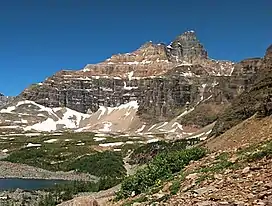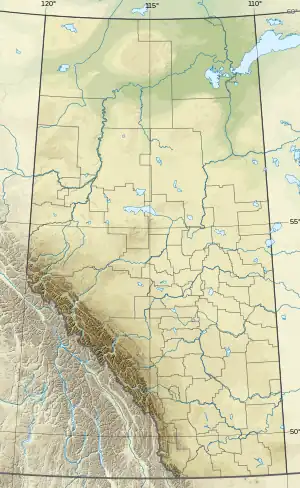Wenkchemna Peak
Wenkchemna Peak is located on the SE ridge coming off of Mount Hungabee on the border of Alberta and British Columbia. It was named in 1894 by Samuel E. S. Allen for the Stoney Indian word for ten.[1][3][5]
| Wenkchemna Peak | |
|---|---|
 Wenkchemna Peak | |
| Highest point | |
| Elevation | 3,170 m (10,400 ft)[1][2] |
| Prominence | 16 m (52 ft)[3] |
| Listing | |
| Coordinates | 51°19′43″N 116°16′35″W[4] |
| Geography | |
 Wenkchemna Peak Location in Alberta and British Columbia  Wenkchemna Peak Wenkchemna Peak (British Columbia) | |
| Country | Canada |
| Provinces | Alberta and British Columbia |
| District | Kootenay Land District[5] |
| Protected areas | Banff National Park and Yoho National Park |
| Parent range | Canadian Rockies |
| Topo map | NTS 82N8 Lake Louise[4] |
| Geology | |
| Type of rock | Sedimentary rock |
| Climbing | |
| First ascent | 1923 F.C. Bell, A.W. Drinnan, H. Herriot, T.B. Moffat, R. Neil, E. Thompson, R. Williams, Christian Hasler Jr.[1][3] |
Wenkchemna is the 10th peak in The Valley of the Ten Peaks, as they are normally numbered (left to right as seen from Moraine Lake). It is an extension into the valley of the ridge formed by Mount Hungabee and Ringrose Peaks.
Geology
Wenkchemna Peak is composed of sedimentary rock laid down during the Precambrian to Jurassic periods. Formed in shallow seas, this sedimentary rock was pushed east and over the top of younger rock during the Laramide orogeny.[6]
Climate
Based on the Köppen climate classification, Wenkchemna Peak is located in a subarctic climate zone with cold, snowy winters, and mild summers.[7] Temperatures can drop below −20 °C with wind chill factors below −30 °C.
See also
Further reading
- Brian Patton, Bart Robinson, Walks and Hikes in Banff National Park, P 103
- Tony Daffern, Canadian Rockies, PP 55, 59
- Brian Patton, Bart Robinson, Canadian Rockies Trail Guide, P 101
- Kathy Calvert, Dale Portman, Guardians of the Peaks: Mountain Rescue in the Canadian Rockies and Columbia, P 185
- Dave Birrell, 50 Roadside Panoramas in the Canadian Rockies, P 83
References
- "Wenkchemna Peak". cdnrockiesdatabases.ca. Retrieved 2023-08-17.
- "Topographic map of Wenkchemna Peak". opentopomap.org. Retrieved 2023-08-17.
- "Wenkchemna Peak". Bivouac.com. Retrieved 2023-08-17.
- "Wenkchemna Peak (Alberta)". Geographical Names Data Base. Natural Resources Canada. Retrieved 2023-08-17.
- "Wenkchemna Peak". BC Geographical Names. Retrieved 2023-08-17.
- Gadd, Ben (2008), Geology of the Rocky Mountains and Columbias
- Peel, M. C.; Finlayson, B. L.; McMahon, T. A. (2007). "Updated world map of the Köppen−Geiger climate classification". Hydrol. Earth Syst. Sci. 11 (5): 1633–1644. Bibcode:2007HESS...11.1633P. doi:10.5194/hess-11-1633-2007. ISSN 1027-5606. S2CID 9654551.